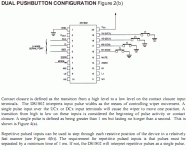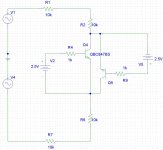Gee Steve... that's a destroyer ship which is about to shoot one lytic missile. 😀
Thankfully is only unity gain
Thankfully is only unity gain

apassgear said:Gee Steve... that's a destroyer ship which is about to shoot one lytic missile. 😀
Hehehe. Yeah, I rather rushed the assembly of that unit so I could get it to the photographers.
Thankfully it didn't launch, but only blew its load of electrolyte all over the circuit board. 😀
se
and the LSK170 is available and cheap enough.
😎
It would be nice to organize a group buy for the Linearsystem . Such LSK389 and LSK170 .
They are really cheap after all .
Sorry if eventually that is already made before and I didnt noticed it .
🙂
For me the R1 information is not clear. I see R1: 1 3W. Please tell me what does "1" mean, may be a typo?
jackup said:For me the R1 information is not clear. I see R1: 1 3W. Please tell me what does "1" mean, may be a typo?
The "1" means 1 ohm. The "3W" means it's a 3 watt resistor.
se
Stepped attenuator
I found a "reasonable" price on a 24 position rotary switch, and since it seems like dual gang linear taper potentiometers are hard to find, I decided to try my hand at making a stepped attenuator (I just can't stand the idea of dual mono pots to be adjusted separately).
My question: will a shunt-type attenuator be a bad idea for this circuit? What I'm worried about is that the pot supplies the input resistance. Is 2K input resistance at the loudest volume enough?
- diomedian
I found a "reasonable" price on a 24 position rotary switch, and since it seems like dual gang linear taper potentiometers are hard to find, I decided to try my hand at making a stepped attenuator (I just can't stand the idea of dual mono pots to be adjusted separately).
My question: will a shunt-type attenuator be a bad idea for this circuit? What I'm worried about is that the pot supplies the input resistance. Is 2K input resistance at the loudest volume enough?
- diomedian
Here is an even easier way to do something similar and yet completely different. This, I think, is my afternoon project sometime in July after F5 and B1 are built.
Dual Audio Taper Potentiometer with Pushbutton Control
http://www.maxim-ic.com/quick_view2.cfm/qv_pk/2778
* Two digitally controlled, 65-position potentiometers
* Ultra low-power consumption
* Software and hardware controlled mute
* Digital or mechanical pushbutton wiper control
* Potentiometers can be linked for stereo control
* Logarithmic resistive characteristics (1dB per step)
* Zero-crossing detection to eliminate noise
* Serial port communication
* Can be daisy-chained for single-processor, multidevice designs
* Operating temperature range: -40°C to +85°C
* Operating voltage range: 3V or 5V
* Resistance available: 45kΩ
$2.56 @ 1k
Dual Audio Taper Potentiometer with Pushbutton Control
http://www.maxim-ic.com/quick_view2.cfm/qv_pk/2778
* Two digitally controlled, 65-position potentiometers
* Ultra low-power consumption
* Software and hardware controlled mute
* Digital or mechanical pushbutton wiper control
* Potentiometers can be linked for stereo control
* Logarithmic resistive characteristics (1dB per step)
* Zero-crossing detection to eliminate noise
* Serial port communication
* Can be daisy-chained for single-processor, multidevice designs
* Operating temperature range: -40°C to +85°C
* Operating voltage range: 3V or 5V
* Resistance available: 45kΩ
$2.56 @ 1k
Attachments
udailey said:Here is an even easier way to do something similar and yet completely different. This, I think, is my afternoon project sometime in July after F5 and B1 are built.
Dual Audio Taper Potentiometer with Pushbutton Control
http://www.maxim-ic.com/quick_view2.cfm/qv_pk/2778
* Two digitally controlled, 65-position potentiometers
* Ultra low-power consumption
* Software and hardware controlled mute
* Digital or mechanical pushbutton wiper control
* Potentiometers can be linked for stereo control
* Logarithmic resistive characteristics (1dB per step)
* Zero-crossing detection to eliminate noise
* Serial port communication
* Can be daisy-chained for single-processor, multidevice designs
* Operating temperature range: -40°C to +85°C
* Operating voltage range: 3V or 5V
* Resistance available: 45kΩ
$2.56 @ 1k
That is what Nelson Pass used in the integrated amp (INT-150).
Log Taper Pot
I don't know why it didn't occur to me before, but can a log taper pot be used instead of the linear taper noted in the article?
The nice digital pot shown above is log taper...
- diomedian
I don't know why it didn't occur to me before, but can a log taper pot be used instead of the linear taper noted in the article?
The nice digital pot shown above is log taper...
- diomedian
Nelson, I saw that the B1 boards will be available on PassDIY, will the B2 boards eventually be available as well?
-Justin
-Justin
Nelson Pass said:Dual buffered bi-amp splitter with volume adjust.
Ah, thanks. Thought it might have been a balanced B1.
se
B2 biamp buffer
Hi Steve,
The B2 Biamp Buffer. You say you tried bi-amping but didn’t get sound you wanted? The B2 uses two pairs of the buffers found in the B1 but configured for splitting the output of the preamp with variable relative gain to two sets of power amplifiers. This allows not only isolated amplifier impedance buffering, but adjusts the gain levels for different amplifiers. Even for identical amplifier channels it also allows the subtle adjustment required to get exactly the top/bottom balance you need.
Hi Steve,
The B2 Biamp Buffer. You say you tried bi-amping but didn’t get sound you wanted? The B2 uses two pairs of the buffers found in the B1 but configured for splitting the output of the preamp with variable relative gain to two sets of power amplifiers. This allows not only isolated amplifier impedance buffering, but adjusts the gain levels for different amplifiers. Even for identical amplifier channels it also allows the subtle adjustment required to get exactly the top/bottom balance you need.
udailey said:Here is an even easier way to do something similar and yet completely different. This, I think, is my afternoon project sometime in July after F5 and B1 are built.
Dual Audio Taper Potentiometer with Pushbutton Control
http://www.maxim-ic.com/quick_view2.cfm/qv_pk/2778
* Two digitally controlled, 65-position potentiometers
* Ultra low-power consumption
* Software and hardware controlled mute
* Digital or mechanical pushbutton wiper control
* Potentiometers can be linked for stereo control
* Logarithmic resistive characteristics (1dB per step)
* Zero-crossing detection to eliminate noise
* Serial port communication
* Can be daisy-chained for single-processor, multidevice designs
* Operating temperature range: -40°C to +85°C
* Operating voltage range: 3V or 5V
* Resistance available: 45kΩ
$2.56 @ 1k
Where I can find the "schematic" (application) ?
I want the simplest one !
BJT switch attenuator
Hi Guys,
Here is my take on a BJT switch for a nice attenuator. It came to me this morning and i can't wait to wire it up tonight. It should have good BW and no DC offset, the only backside is that one needs two floating switch control voltages that are fairly well matched, the last bit of assymmetry can be trimmed away by adjusting individually for each switch R4 or R9.
BR,
Anders
Hi Guys,
Here is my take on a BJT switch for a nice attenuator. It came to me this morning and i can't wait to wire it up tonight. It should have good BW and no DC offset, the only backside is that one needs two floating switch control voltages that are fairly well matched, the last bit of assymmetry can be trimmed away by adjusting individually for each switch R4 or R9.
BR,
Anders
Attachments
- Home
- Amplifiers
- Pass Labs
- B1 Buffer Preamp

